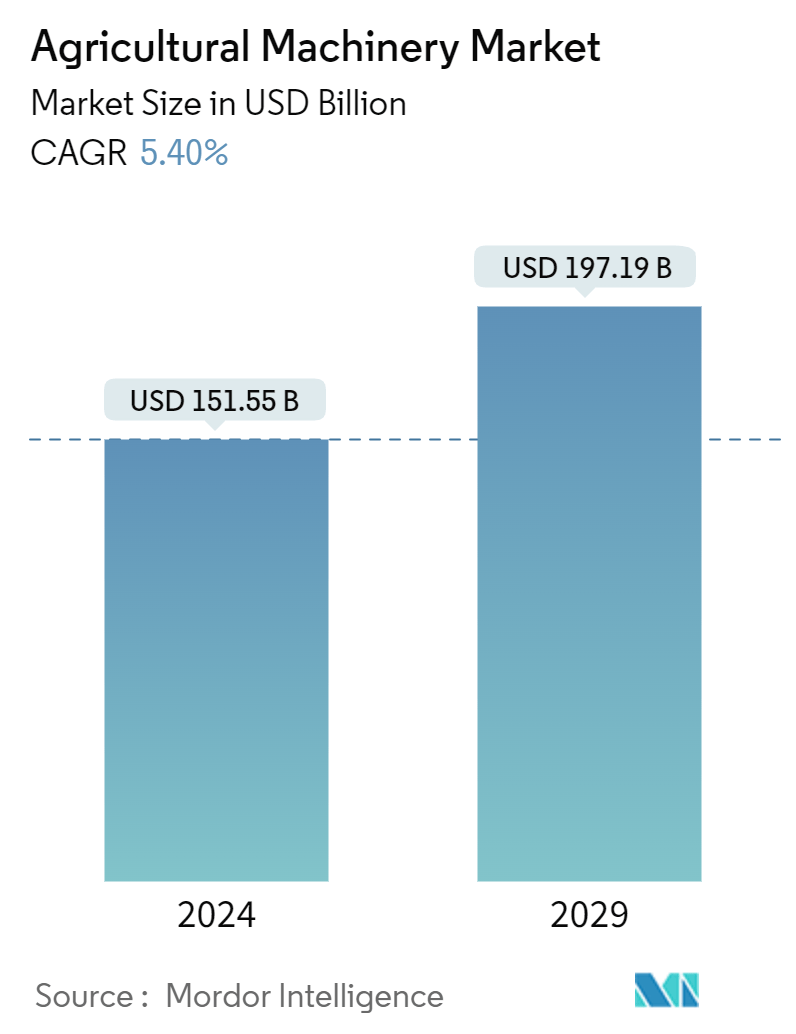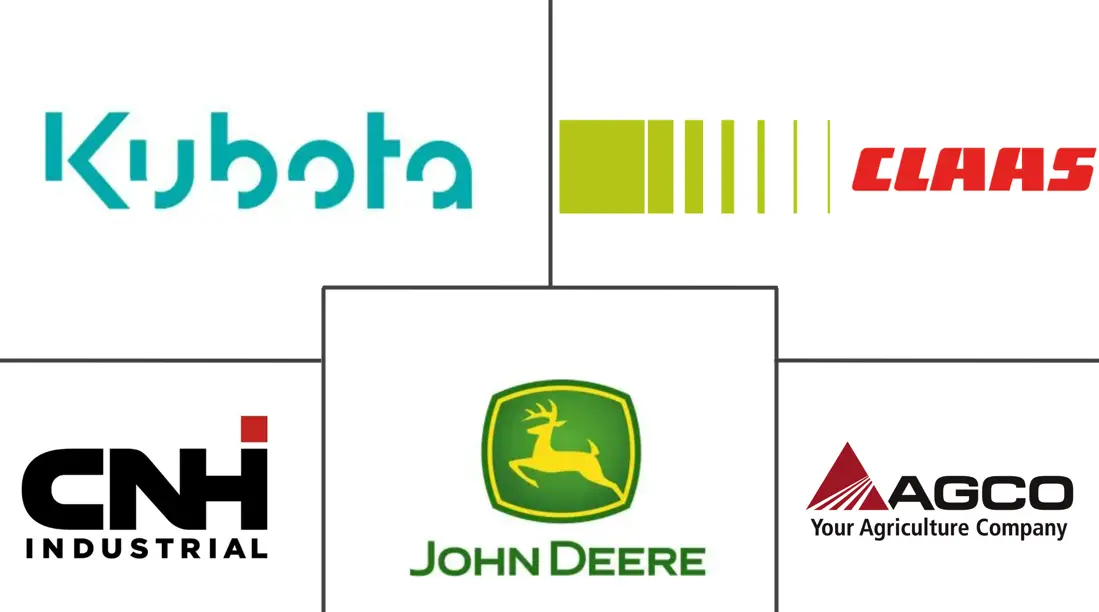Market Size of Agricultural Machinery Industry

| Study Period | 2019 - 2029 |
| Market Size (2024) | USD 151.55 Billion |
| Market Size (2029) | USD 197.19 Billion |
| CAGR (2024 - 2029) | 5.40 % |
| Fastest Growing Market | Asia-Pacific |
| Largest Market | Asia-Pacific |
| Market Concentration | High |
Major Players
*Disclaimer: Major Players sorted in no particular order |
Agricultural Machinery Market Analysis
The Agricultural Machinery Market size is estimated at USD 151.55 billion in 2024, and is expected to reach USD 197.19 billion by 2029, growing at a CAGR of 5.40% during the forecast period (2024-2029).
Agricultural machinery has been growing steadily in Europe and North America during the study period. Rising mechanization in the regional agriculture sector and the surge in farmers’ income are likely to be a primary factor driving the growth. Moreover, as the push to enhance agricultural land productivity intensifies, it is expected to persist during the forecast period. This, in turn, is expected to drive farmers and land operators to adopt automation technologies in their equipment increasingly. While agriculture remains a key sector in the region’s economy, there has been a significant decrease in the number of individuals employed in this field. This has resulted in an annual labor shortage crisis for the agricultural industry. According to the World Bank, the employment rate in agriculture (% of total employment) in North America decreased from 1.73% in 2020 to 1.63% in 2021. Thus, the shortage of farm labor increased the wage rates in the industry, thereby raising the demand for farm machinery, which contributed to the market's growth during the forecast period.
Further, the need for sustainability in managing farm operations has induced the demand for highly developed and efficient machinery in recent years and is driving the growth of the market studied. For instance, according to the Association of Equipment Manufacturers (AEM), the total number of tractors and combines sold in 2021 in North America was 360,000 units. That year, there was an increase in sales of over 10% in nearly every segment of agricultural tractors and combines in the United States and Canada. Besides, the favorable programs of the country’s government to enable agricultural mechanization, offering support and financing for the purchase of agriculture machinery and equipment, and training for the operators of agricultural machinery have been driving the agriculture machinery market. For instance, in March 2022, the Government of Canada invested over USD 860,000 in agriculture machinery innovation and technology to tackle challenges in agriculture. These projects are supporting Canadian agricultural technology companies as they develop innovative solutions to help farmers reduce waste, conserve resources, and improve efficiency. Therefore, the increasing demand for agricultural machinery, with the rising farm mechanization, along with the technological advancements and innovations by the major players, are contributing to the market’s growth during the forecast period.
Agricultural Machinery Industry Segmentation
Agricultural machinery includes machines and tools used in fields for various farming activities, including harvesting, plowing, irrigation, and planting. The agricultural machinery market is segmented by Type into tractors, plowing and cultivating machinery, planting machinery, irrigation machinery, harvesting machinery, haying and forage machinery, and other types and by geography into North America, Europe, Asia-Pacific, South America, and Africa. The report offers the market size and forecasts in terms of value (USD) for all the above segments.
| Type | ||||||||||||
| ||||||||||||
| ||||||||||||
| ||||||||||||
| ||||||||||||
| ||||||||||||
| ||||||||||||
| Other Types |
| Geography | |||||||
| |||||||
| |||||||
| |||||||
| |||||||
|
Agricultural Machinery Market Size Summary
The agricultural machinery market is poised for significant growth, driven by the increasing need for efficient farming solutions amid declining arable land and a shrinking labor force. The sector is experiencing a surge in mechanization, particularly in high-income regions like North America and Asia-Pacific, where agriculture and dairy industries are robust. Governments worldwide are actively promoting agricultural mechanization through financial support and training programs, aiming to enhance food security and improve agricultural productivity. The market is characterized by the presence of major players such as Deere & Co., CNH Industrial, AGCO Corporation, Kubota, and Claas Group, who are focusing on innovation, expansion, and strategic partnerships to maintain their competitive edge.
The demand for agricultural machinery is further fueled by urbanization, which is drawing rural labor to cities, thereby increasing the reliance on mechanized farming solutions. Countries like China and India are significant contributors to the global agricultural machinery market, with China being a leading producer and India witnessing a rise in tractor production and sales. The market is also witnessing technological advancements, such as the introduction of electric and autonomous machinery, which are set to enhance sustainability and efficiency in farming operations. As the industry continues to evolve, the consolidation of market players through mergers and acquisitions is expected to expand their geographical reach and technological capabilities, further driving market growth.
Agricultural Machinery Market Size - Table of Contents
-
1. MARKET DYNAMICS
-
1.1 Market Overview
-
1.2 Market Drivers
-
1.2.1 Declining Agricultural Labor
-
1.2.2 Rising Technological Advancements
-
1.2.3 Increasing Government Support to Enhance Farm Mechanization
-
-
1.3 Market Restraints
-
1.3.1 Increasing Farm Expenditure
-
1.3.2 Security Concerns in Modern Farming Machinery
-
-
1.4 Porter's Five Forces Analysis
-
1.4.1 Threat of New Entrants
-
1.4.2 Bargaining Power of Buyers
-
1.4.3 Bargaining Power of Suppliers
-
1.4.4 Threat of Substitute Products
-
1.4.5 Intensity of Competitive Rivalry
-
-
-
2. MARKET SEGMENTATION
-
2.1 Type
-
2.1.1 Tractors
-
2.1.1.1 Horsepower
-
2.1.1.1.1 Less than 40 HP
-
2.1.1.1.2 40 HP to 99 HP
-
2.1.1.1.3 Greater than 100 HP
-
-
2.1.1.2 Type
-
2.1.1.2.1 Compact Utility Tractors
-
2.1.1.2.2 Utility Tractors
-
2.1.1.2.3 Row Crop Tractors
-
-
-
2.1.2 Plowing and Cultivating Machinery
-
2.1.2.1 Plows
-
2.1.2.2 Harrows
-
2.1.2.3 Cultivators and Tillers
-
2.1.2.4 Other Plowing and Cultivating Machinery
-
-
2.1.3 Planting Machinery
-
2.1.3.1 Seed Drills
-
2.1.3.2 Planters
-
2.1.3.3 Spreaders
-
2.1.3.4 Other Planting Machinery
-
-
2.1.4 Harvesting Machinery
-
2.1.4.1 Combine Harvesters-Threshers
-
2.1.4.2 Forage Harvesters
-
2.1.4.3 Other Harvesting Machinery
-
-
2.1.5 Haying and Forage Machinery
-
2.1.5.1 Mower-conditioners
-
2.1.5.2 Balers
-
2.1.5.3 Other Haying and Forage Machinery
-
-
2.1.6 Irrigation Machinery
-
2.1.6.1 Sprinkler Irrigation
-
2.1.6.2 Drip Irrigation
-
2.1.6.3 Other Irrigation Machinery
-
-
2.1.7 Other Types
-
-
2.2 Geography
-
2.2.1 North America
-
2.2.1.1 United States
-
2.2.1.2 Canada
-
2.2.1.3 Mexico
-
2.2.1.4 Rest of North America
-
-
2.2.2 Europe
-
2.2.2.1 Germany
-
2.2.2.2 United Kingdom
-
2.2.2.3 France
-
2.2.2.4 Rest of Europe
-
-
2.2.3 Asia-Pacific
-
2.2.3.1 China
-
2.2.3.2 India
-
2.2.3.3 Japan
-
2.2.3.4 Australia
-
2.2.3.5 Rest of Asia-Pacific
-
-
2.2.4 South America
-
2.2.4.1 Brazil
-
2.2.4.2 Argentina
-
2.2.4.3 Rest of Latin America
-
-
2.2.5 Africa
-
2.2.5.1 South Africa
-
2.2.5.2 Rest of Africa
-
-
-
Agricultural Machinery Market Size FAQs
How big is the Agricultural Machinery Market?
The Agricultural Machinery Market size is expected to reach USD 151.55 billion in 2024 and grow at a CAGR of 5.40% to reach USD 197.19 billion by 2029.
What is the current Agricultural Machinery Market size?
In 2024, the Agricultural Machinery Market size is expected to reach USD 151.55 billion.

